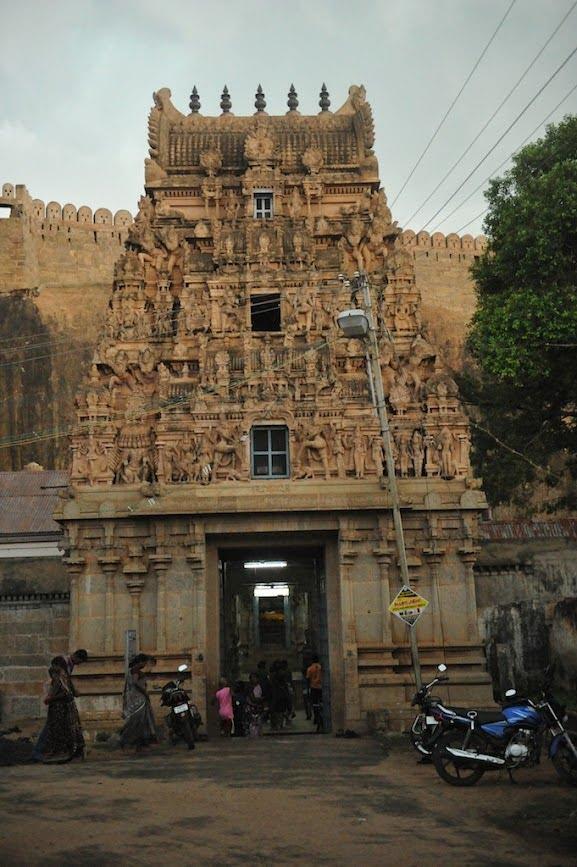According to the Sthala Purana, while Lord Vishnu was in Yoga Nidra on Adishesha, two demons, Madhu and Kaidaba, attempted to abduct Mother Mahalakshmi and Mother Bhoodevi. In fear, Mahalakshmi took refuge in Lord Vishnu’s chest, and Bhoodevi hid at His feet. To protect them without disturbing Lord Vishnu’s sleep, Adishesha expelled the demons using his venom. Concerned about acting without permission, Adishesha was reassured by the Lord, who praised his actions. To commemorate this event, Adishesha is depicted in a shrinking posture.
Sthala Puranam:
The Perumal, who embodies the concept of "Sathyam" (truth), serves as a living example of the universal truth, as reflected in the saying "Satyameva Jayate." In this sacred space, He is known as "Sathya Giri Nathan" to demonstrate and uphold the essence of truth. Truth is eternal, never sleeps, and is always aware of human actions, ensuring that every soul reaches its appropriate destiny. Those who act virtuously will be blessed by the divine feet of Sriman Narayanan, while those who commit evil will face retribution in hell. To illustrate this, the Perumal is depicted in a reclining posture, "Bogha Sayanam," to signify His vigilance and judgement over the actions of all beings.
The Perumal oversees and governs all life on Earth. To convey this, He is also represented in a standing posture as "Sathya Moorthy." In Tamil, the word for truth is "Mei," and the Utsavar (festival deity) is named "Meyyan" (or "Meyyappan"). The deity is depicted in an Anantha Sayanam posture, surrounded by exquisite sculptures reminiscent of those in Mahabalipuram.
In ancient times, during the dominance of the Asuras and the spread of adharma (evil), rituals and sacrifices diminished, causing fear among sages and deities. They appealed to Dharma Devi, the goddess of righteousness, for assistance. Dharma Devi transformed into a deer and came to this sacred land, known as "Venu Vanam" due to its bamboo forest. There, Perumal assured her that He would remain as "Sathya Giri Nathan" to protect and guide all beings.
Athiri Muni and his wife Anusuya, devoted to the Perumal, performed tapas to have divine children. The gods agreed to this request: as the hamsam (incarnation) of Sri Vishnu, Dattatreya was born; as the hamsam of Lord Shiva, the Moon God was born; and as the hamsam of Brahma, another child was born. These children were taught the Vedas and mantras and sent to perform tapas. The Moon God, seeking residence in the Chandra Mandalam (Moon's domain), was granted his wish by the Perumal.
The temple features a grand RajaGopuram (gateway tower) and is renowned for its impressive architecture and historical significance. The main deity, Sathya Giri Nathan, is depicted in a standing posture, while another shrine houses Perumal in a reclining posture, larger than the one in SriRangam. The temple complex includes intricately carved pillars and separate sanctums for Sri Krishna, Sri Andal, Chakrathalwar, and Narasimha.
In the western part of the temple, Perumal in Bogha Sayana Moorthy (reclining posture) is seen as larger than the Ranganathar in SriRangam. Adhisesha, depicted with a shrunken head, symbolises his role in protecting Bhoomi Piratti and fighting the demons.
The temple is adorned with detailed sculptures and paintings, similar to those in Mahabalipuram. Nearby, there is the "Keeyai Kovil" with a shrine for Lord Shiva, named "Sathya Gireeswarar," constructed by Mahendra Pallavan to honor both Vaishnavism and Shaivism.
The surrounding area includes the picturesque Vaishnavi Durgai hill, famous for its beauty and the presence of Vaishnavi Durgai.
